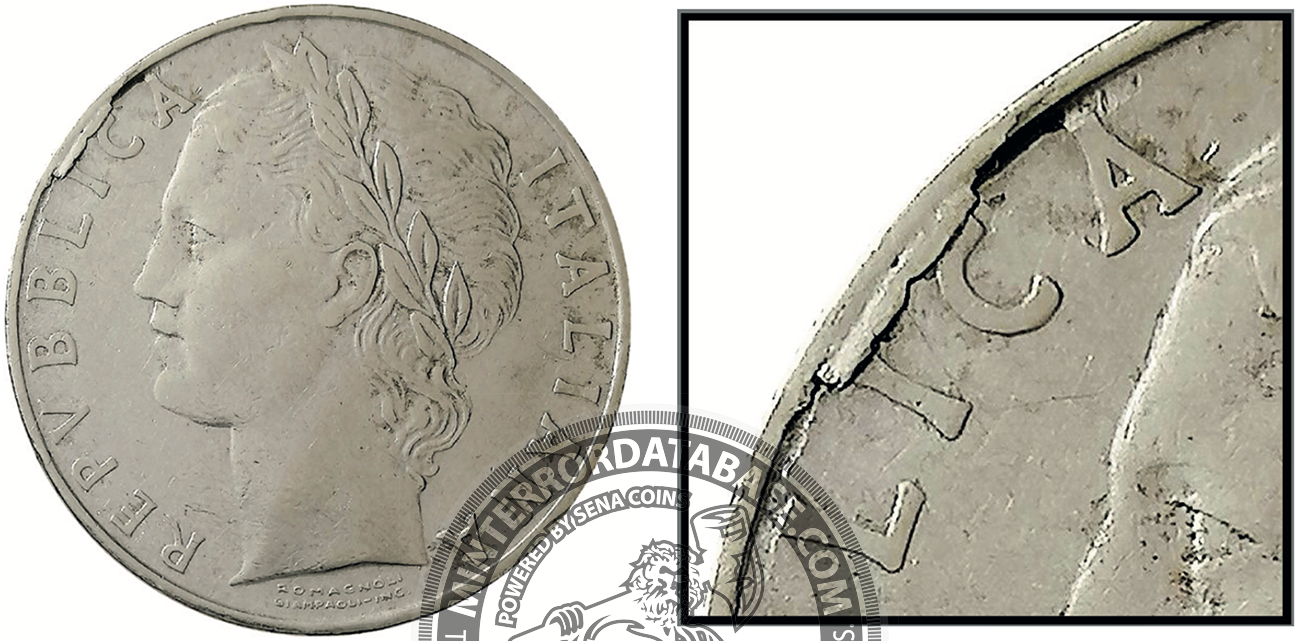Alloy errors
Coins that have imperfections in the composition of the metal alloy are generally common, except in some extreme cases.
These differences in the composition of the alloy can arise in the foundry during the casting process.
The different metals that make up the alloy must be dosed in the right proportions to obtain planchets in compliance with the issue decree. In the event that the metals were amalgamated in wrong doses during the melting phase, the following variations could be found:
• Change in the color of the alloy
• Variation in the specific weight of the alloy
• Change in magnetic attraction of the alloy
• Change in the porosity of the alloy
The variations listed above in the coins minted on planchets with imperfections in the alloy generate the following differences:
• Different reflection of light on the field of the coin; the field of the coin may be opaque in some places including the outline.
• Difference in the color of the coin; the field of the coin can have different colors, sometimes homogeneous and other times streaked or spotted. The colors may vary according to the inclination of the coin with respect to the position of the light.
• Difference in the specific weight of the coin: a greater or lesser quantity of the heavier metal used for the preparation of a specific alloy could lead to a difference in the specific weight of the same.
• Different magnetic attraction of the coin:
Ferromagnetic coins have very intense elementary magnetic moments (strongly attracted to the magnet).
Paramagnetic coins have rather weak elementary magnetic moments (weakly attracted to the magnet).
Diamagnetic coins have magnetic moments equal to zero because inside them the magnetic effects of the individual electrons compensate for each other.
The B0-> field disturbs this balance and creates a weak magnetic moment with the opposite direction to that of B0-> (weakly repelled by the magnet). An example of such differences can be found in the Acmonital coins of the Kingdom of Italy (Empire and Kingdom of Albania series 1936-1943 Steel with austenic microstructure).
• Different porosity of the alloy: surface of the porous coin.
Alternatively, the constituent metals can be dosed in the right proportions but poorly mixed. These imperfections are manifested by clearly visible dark and light streaks on both sides of the coin, including the border. Of course, the two errors can occur together.
We can find an example of this phenomenon in the cents of the Kingdom of Italy as there are examples that highlight these particularities. During the flattening of the sheet intended for shearing the rounds (Lamination) these streaks tend to expand further, highlighting this phenomenon (E.T.1 and E.T.2).


The most extreme and improper alloy mixing imperfections are those in which the minor metal element is not mixed at all. This phenomenon is called intrinsic metal inclusion.
In Italy, this phenomenon is unknown due to the impossibility of finding coins with this melting defect.
On rare occasions, a gas pocket forms which expands when the round is struck by the coin. The heat generated by the beating is believed to be responsible for the expansion of the gas. The expanding gas pushes the overlying metal upwards, producing a planchet swelling with soft edges. If the roof remains intact, the imperfection is referred to as an occluded gas bubble. If the roof bursts from internal pressure it is referred to as a broken gas bubble. If the roof is thin, it will flex or a dimple will remain visible when pressed with the tip of a toothpick. If the roof is thick, it may not give in to pressure. (E.T.3 and E.T.4).



Aluminum metal alloys
The main binders used for aluminum to make up the master alloys are: Copper (Cu), Silicon (Si), Magnesium (Mg), Zinc (Zn), Manganese (Mn) and lithium (Li).
Alongside them, other elements can be used that improve some performance aspects of the alloys known as corrective. There are additions for particular purposes, i.e. to increase or decrease certain characteristics, small percentages of Nickel (Ni), Titanium (Ti), Zirconium (Zr), Chromium (Cr), Bismuth (Bi), Lead (Pb), Cadmium (Cd ), Scandio (Sc), Tin (Sn) and Iron (Fe). Iron always present as an impurity. Each element produces a certain effect, that is, it gives the alloy a certain property.
Copper metal alloys
There are numerous copper alloys, therefore it was necessary to divide them into families with their own specific name.
• Brass (Copper + Zinc)
• Bronzes (Copper + Tin)
• Cupronickel (Copper + Nickel)
• Alpacche (Copper + Zinc + Nickel)
• Various bronzes: the main additional element is not tin but other metals such as aluminum bronzes (also called Cuprallumini), phosphorus, silicon, beryl, etc.
The main binders used for Copper to make up the master alloys are: Zinc (Zn), Tin (Sn), Aluminum (Al), Nickel (Ni), Lead (Pb), Manganese (Mn) etc.
Cupronickel (CuNi) Chemical formula = CuNi20: it is an alloy composed of Copper, where the main alloying agent is Nickel. It is characterized by excellent mechanical strength in addition to its resistance to corrosion. A content of 20% nickel is enough to completely whiten the copper and obtain a metallic gray color similar to aluminum.
• Cu = Copper of pink or reddish color, non-ferrous metal, diamagnetic.
• Ni = Silvery nickel, ferrous metal, ferromagnetic.
Use the keyword alloy errors in the global search engine to view all the coins with this type of error. Login or Sign up to insert new coins in the search engine and know the prices and rarity of all the coins in our database. The service is totally free.
© 2020-2024 Sena Coins - All rights reserved.